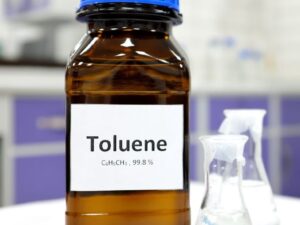Description
Styrene Monomer: A Versatile Building Block of Modern Materials
Styrene monomer, a colorless to yellowish oily liquid with a characteristic aromatic odor, is a vital organic compound serving as the foundation for a vast array of everyday products. While perhaps not a household name, styrene monomer is the unseen hero behind countless plastics, rubbers, and resins that shape our modern world.
The Chemistry of Styrene:
Styrene, also known as vinylbenzene, is chemically represented as C8H8. Its structure consists of a benzene ring with a vinyl group (CH=CH2) attached. This unique combination grants styrene its reactivity, allowing it to undergo polymerization reactions to form long chains called polymers. This polymerization process is the key to its versatility.
The Making of Styrene:
The vast majority of styrene is produced industrially through the dehydrogenation of ethylbenzene. Ethylbenzene, in turn, is primarily obtained from the alkylation of benzene with ethylene. This large-scale production process highlights the importance of styrene and its reliance on the petroleum industry.
From Monomer to Polymer: A World of Applications:
The real magic of styrene lies in its ability to form polymers. Depending on the specific polymerization process and the addition of other additives, styrene monomer can be transformed into various polymers with diverse properties:
- Polystyrene (PS): This is perhaps the most well-known polymer of styrene. Polystyrene is rigid, transparent, and relatively inexpensive. It finds applications in packaging (foam and rigid containers), insulation (Styrofoam), and disposable products like cups and cutlery.
- High-Impact Polystyrene (HIPS): By adding butadiene rubber during polymerization, HIPS is created. This version is much tougher and more impact-resistant than regular polystyrene. It’s used in appliance housings, automotive parts, and toys.
- Acrylonitrile Butadiene Styrene (ABS): ABS is a terpolymer composed of acrylonitrile, butadiene, and styrene. This combination provides a balance of hardness, toughness, and chemical resistance. ABS is widely used in automotive interiors, electronic housings, toys (like LEGO bricks), and piping.
- Styrene-Butadiene Rubber (SBR): SBR is a synthetic rubber copolymer produced from styrene and butadiene. It is a common substitute for natural rubber and is used extensively in tires, shoe soles, and other rubber products.
- Unsaturated Polyester Resins: Styrene is used as a co-monomer in unsaturated polyester resins. These resins, when combined with fiberglass reinforcement, create strong and lightweight composite materials used in boat hulls, automotive body panels, and construction materials.
Safety and Handling:
While essential to many industries, styrene monomer requires careful handling due to its potential hazards. It is a flammable liquid, and its vapors can be irritating to the eyes, skin, and respiratory system. Prolonged or repeated exposure can lead to more serious health concerns. Therefore, manufacturers and processors must adhere to strict safety protocols, including proper ventilation, personal protective equipment, and storage guidelines.
Environmental Considerations:
The production and disposal of products containing styrene-based polymers also raise environmental concerns. Polystyrene, in particular, is notorious for its slow degradation rate and contribution to plastic pollution. Recycling efforts are crucial for managing styrene-based materials and reducing their environmental impact. Research is also ongoing to develop more sustainable alternatives and improved recycling technologies.
The Future of Styrene:
Despite the challenges, styrene monomer remains a critical building block for modern industry. As demand for plastics and other synthetic materials continues to grow, so too will the need for styrene. Ongoing research and development efforts are focused on improving the sustainability of styrene production, enhancing the recyclability of styrene-based polymers, and exploring bio-based alternatives to reduce reliance on petroleum-derived sources.
In conclusion, while often unseen, styrene monomer plays a vital role in shaping the materials we use every day. From the packaging that protects our food to the components of our cars, styrene-based polymers contribute significantly to our modern lifestyle. Understanding its properties, applications, and associated challenges is essential for ensuring its responsible and sustainable use in the future.



















Reviews
There are no reviews yet.